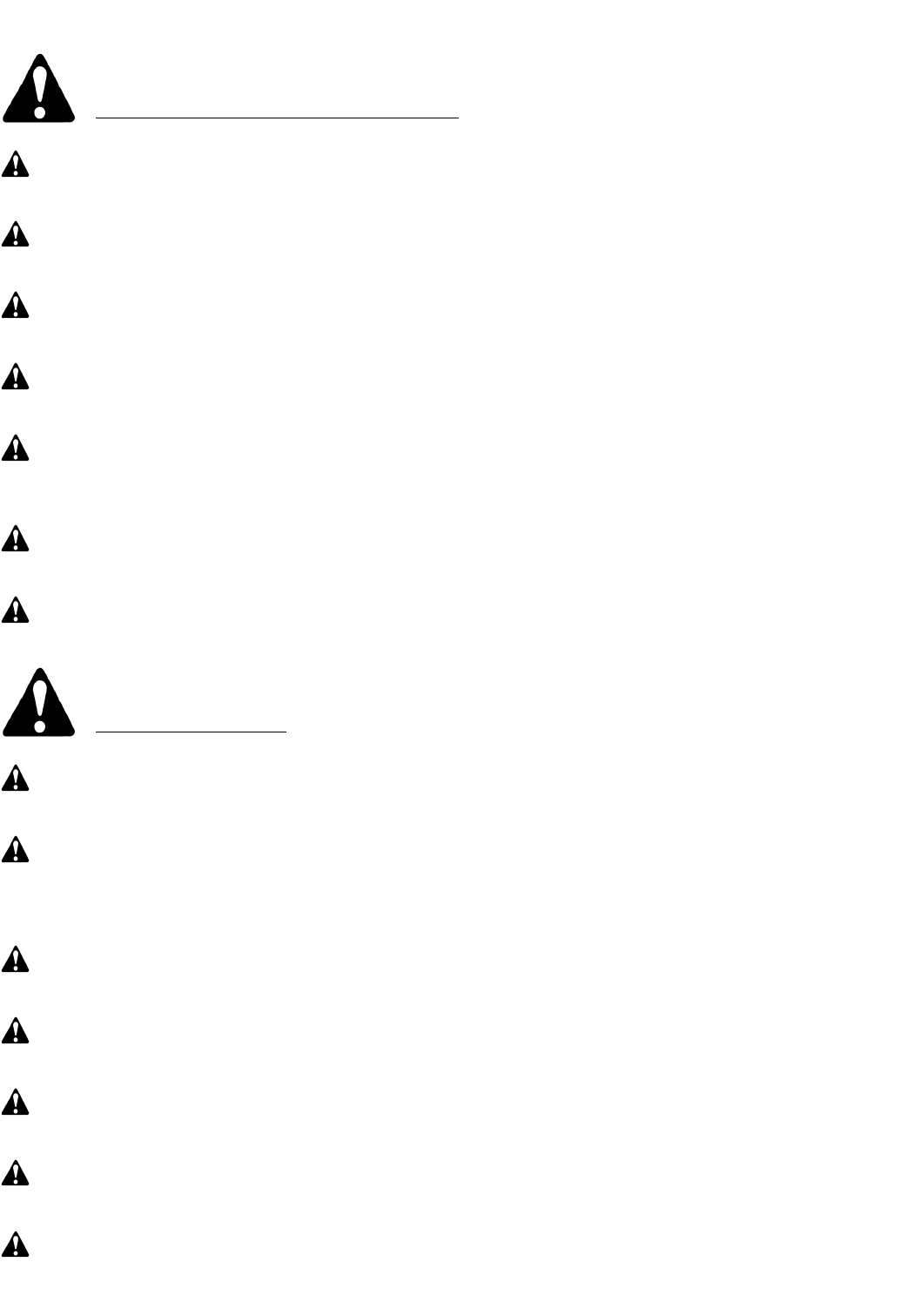
17
12
SAFETY INSTRUCTIONS (continued)
After servicing, be sure all tools, parts and service equipment are removed.
Check to ensure all safety signs are installed and in good condition. (See safety sign section for location
drawing.)
Do not allow grease or oil to build up on any deck or platform.
Never replace hex bolts with less than grade five bolts unless otherwise specified, i.e. shear bolts. Refer to bolt
torque chart for head identification marking.
Where replacement parts are necessary for periodic maintenance and servicing, genuine factory replacement
parts must be used to restore your equipment to original specifications.The manufacturer will not claim respon-
sibility for use of unapproved parts and/or accessories and other damages as a result of their use.
If equipment has been altered in any way from original design, the manufacturer does not accept any liability
for injury or warranty.
A fire extinguisher and first aid kit should be kept readily accessible while performing maintenance on this
equipment.
Following operation or when unhooking, stop the tractor, set the brakes, disengage the PTO, shut off the
engine and remove the ignition keys.
Never unhitch without using the tongue jack. The tongue is very heavy. Attempting to lift the tongue without
using the tongue jack could cause strains. Allowing the tongue to fall suddenly and unexpectedly could result
in crushing injury. Use the tongue jack for lifting the implement only.Overloading the jack can cause failure with
possible serious bodily injury or even death.
Store the unit in an area away from human activity.
Do not park equipment where it will be exposed to livestock for long periods of time. Damage and livestock
injury could result.
Do not permit children to play on or around the stored unit.
Make sure all parked machines are on a hard, level surface and engage all safety devices.
If blocking is used, make sure it is solid and secure before leaving area.
MAINTENANCE SAFETY (continued)
ST
ORAGE SAFETY
INSTRUCTIONS (continued)
Improper use of loaders to handle bales can result in
serious injury or death to the operator. This could be
caused by the bale tumbling back down the loader into
the operator’s station.
For optimum stability and visibility:
• Become familiar with controls.
• Be sure anyone operating the loader is aware of safe
operation and potential hazards. Read and observe
safety recommendations in loader manual.
• Operate loader from operator’s seat only. Remain at
controls until operating cycle is complete.
• Carry the bale slowly and as low as possible to the
ground.
• Operate the loader hydraulic controls smoothly,
avoiding jerky operation.
• When handling round bales on a slope, always
approach the bale with the power unit facing uphill.
• Never use the tractor/loader to stop a rolling bale.
• Stop loader gradually when lowering or lifting loads.
• Use particular care when working on inclines and
hillsides.
• Avoid holes, ditches, and obstructions which may
cause tractor/loader to tip.
• Allow for additional length of loader on tractor while
turning.
• Never allow anyone to walk or work under a raised
loader.
• Be sure that people, livestock, or pets are not stand-
ing near the machine while operating.
• Travel slowly over rough ground or when making
turns.
• Drive slowly through gates and doors.
• Lower bucket or attachment to ground when loader is
unattended.
HANDLE BALES SAFELY
When working on side hills, DO NOT
RAISE LOADER TOO HIGH. Keep an
eye on terrain changes. Keep load low.
WARNING!
For multiple spear models, always insert spears
into the bale – NEVER under the bale. Failure to insert
spears into bale can allow bale to roll back when
loader is raised, causing serious injury or death.
CAUTION!
When traveling on public roads, whether at night or
during the day, use accessory light and devices for
adequate warnings to operators of other vehicles.
Comply with all federal, state and local laws.
Carry load low.
Check visibility. If visibility is impaired, reduce speed or
consider other means of bale transport.
Allow for additional length of loader and spear attach-
ment on tractor while turning.
Select a safe ground travel speed when transporting
from one area to another. When traveling on roadways,
transport in such a way that faster moving vehicles may
pass you safely.
When traveling over rough or hilly terrain or when
making turns, slow down and use extra care.
Read all the safety warnings in the front of this manu-
al and in the manual of tractor.
TRANSPORTING
——————————————————


















